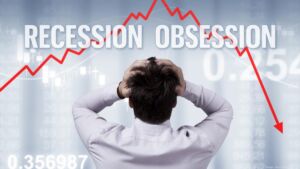June’s big payroll jump helped clear away some of those recession clouds for a U.S. economy that nonetheless faces some stormy weather ahead.
Job gains of 372,000 convinced most Wall Street economists that the idea of a first-half recession is “fanciful,” as one put it. A 3.6% unemployment rate is hardly consistent with an economic downturn, at least for the six months of 2022 that are in the rear view.
But there will still be plenty to deal with ahead as persistently high inflation and multiple rounds of interest rate hikes test the economy’s ability to stay strong.
“I think we have a ways to go,” said Vincent Reinhart, chief economist at Dreyfus and Mellon. “This was a report long on evidence of aggregate demand and short on evidence of aggregate supply. But four months in a row of almost 400,000 jobs created makes you feel a little bit different about the possibility of two quarters in a row of declining GDP.”
For the record, the U.S. economy contracted 1.6% in the first quarter and is on pace to decline 1.2% in the second quarter, according to the Atlanta Federal Reserve’s GDPNow tracker. Two quarters in a row of negative GDP is a widely accepted definition of a recession.
Potential trouble spots
That comes, though, with monthly job growth this year averaging 457,000, even with a modest slowdown that began in March. The unemployment rate has held at 3.6% the past four months, a combination of solid payrolls gains and stubbornly low growth in the labor force.
Still, there were a few weak signs in the report, such as a decline of 315,000 in the Labor Department’s survey of households. The labor force saw an exodus of 353,000, and there are still about two job openings for every available worker, exacerbating an inflationary phenomenon in which supply has badly lagged demand across the economy.
Then there’s the larger notion that the unemployment rate is the worst leading indicator of a recession, with jobs usually continuing to rise in the early days of a recession and then continuing to fall in the early days of a recovery.
But anyone trying to find signs of a recession in corporate America’s hiring practices would come up empty.
“Overall, the jobs data support our view that talk of the economy being in recession right now is fanciful, while the wages numbers suggest inflation pressure is easing,” wrote Ian Shepherdson, chief economist for Pantheon Macroeconomics. He added that “the recession story was over-priced” by markets and the Fed is still likely to keep raising interest rates.
Focus on inflation and rates
It’s those rate hikes, and the inflation they seek to control, that generate worry that all is far from clear for the domestic economy.
Average hourly earnings rose 0.3% from a month ago but were still up 5.1% on a 12-month basis. The stronger-than-expected wage and jobs numbers are unlikely to dissuade Fed officials from approving a 75 basis point interest rate increase at their meeting later in July.
Inflation overall was running at an 8.6% annual rate in May, according to the consumer price index. Fresh CPI data comes out Wednesday, with economists expecting that number could be even higher considering the surge in gas prices for the month.
Should inflation persist and rate hikes continue, that could slow the economy enough to send it into recession within the next year or so. Multiple economists have been raising their recession odds recently, expecting a downturn to start either late in 2022 or early next year.
“The U.S. economy is still expanding, and job growth is strong enough to avoid a recession for now, but aggressive rate hikes could lead to a material slowdown,” Wilmington Trust said in a response to the jobs report. “We expect the U.S. and global economies to avoid recession over the next 9-12 months, but risks have risen.”
Investors are watching the jobs and inflation reports closely, and also have been keeping an eye on the Atlanta Fed’s GDP gauge, which adjusts regularly with incoming data and gets more reliable as the end-of-quarter data rolls in. The tracker had been looking for a 1.9% decline for the second quarter, but Friday’s data improved that picture to a drop of 1.2%.
While that still puts the U.S. in what traditionally has been considered a recession, Atlanta Fed President Raphael Bostic told CNBC the branch’s economists see the economic picture as fairly bright.
“The core of the U.S. economy still looks very strong, and that’s what we should focus on,” he told CNBC’s Steve Liesman during a “Squawk Box” interview.
Bostic stressed the need to get inflation under control, but in relation to the GDPNow indicator, he said there’s “a lot more than just any one number can tell you.”
“Our focus is still pretty positive about where the economy is,” he said. “We are worried about inflation, and that to me is where our focus really has gravitated toward over the last several months. … We’re going to try to get inflation down while still keeping the economy as strong as possible.”

